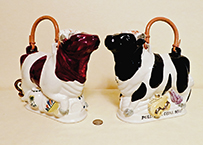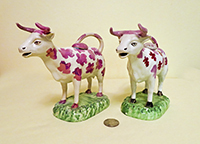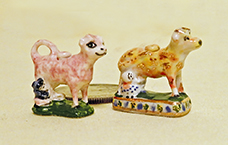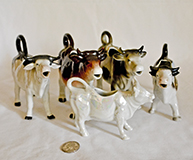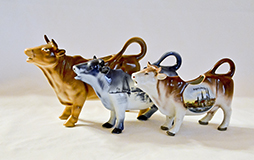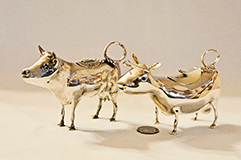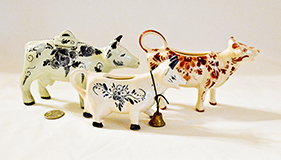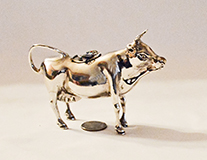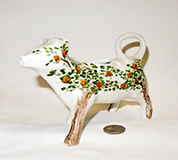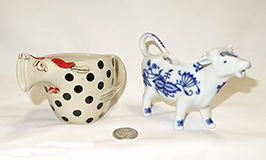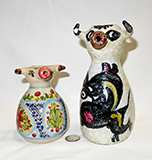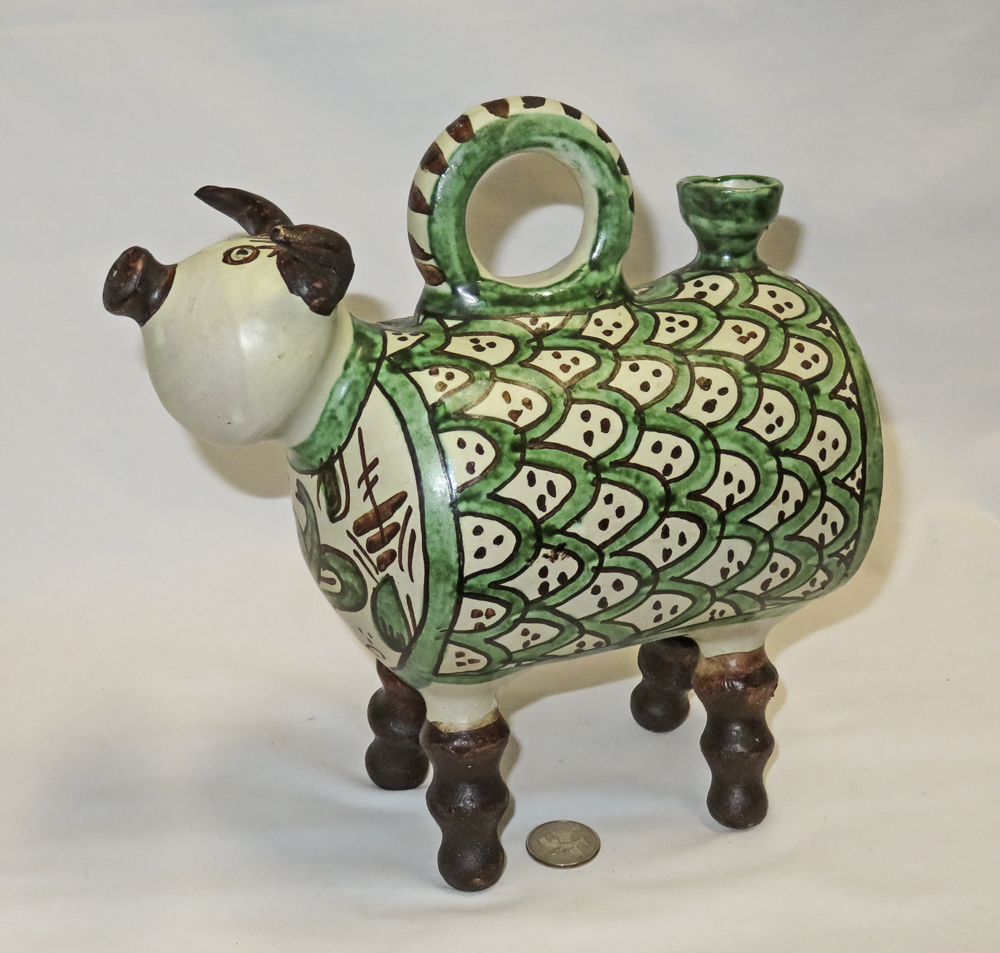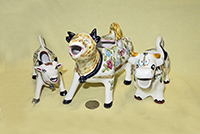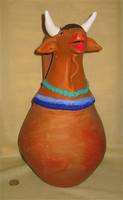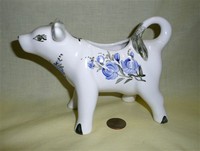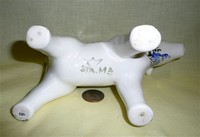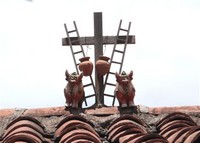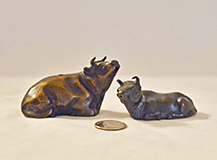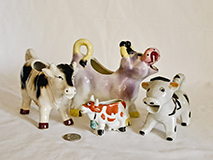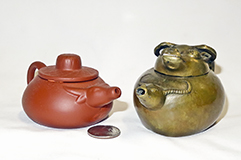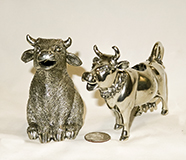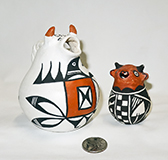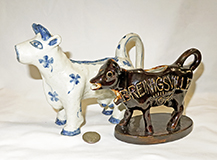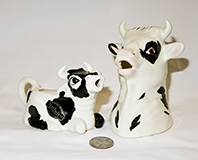
Places of Origin
Like most other things these days, many of ‘new’ cow creamers, pitchers, and teapots are “Made in China”, irrespective of the brand, designer, or importer/merchandiser. For a while of course Japan had much the same market influence and a good many are still manufactured there, for companies from many countries. Most of those Chinese and Japanese cows are scattered through the various categories (e.g., Teapots, miniatures, Modern Variations) since the place of manufacture is not all that important. However some bear a unique flavor of Japan or China, and were either made for local use or bear no attribution to a ‘foreign’ designer, so are featured here.
As with my other categories, this one is neither ‘pure’ nor complete. I have put creamers that come from or are attributed to geographic areas (or types of clay or glaze) that are particularly prominent in my collection such as “Bennington”, “Staffordshire”, “Jackfield”, and “Delft” in their own separate categories. Some other country-specific creamers are shown under ‘Favorite Brands', e.g. Kent (England) or Schafer & Vater and Goebel (Germany). Here I give examples of creamers (and a few teapots and suiteki)that seem to me to be characteristic of their country or region.
| England:While as noted on the history page cow creamers per se may have originated in Holland, their popularity and profusion really blossomed in England, first in London with silver ones, then from the potteries in Staffordshire, so that England in many ways can claim to be ‘home’ to them. My collection has hundreds of modern English cow creamers in addition to the silver and “Staffordshire” ones, and many of those come from potteries in and around the historic Staffordshire city of Stoke-on-Trent. As discussed on the Staffordshire page, this city comprises six distinct towns: Tunstall, Burslem, Hanley, Stoke, Fenton and Longton – which due to the predominance of this industry are collectively known as “The Potteries”. Indeed the Stoke-on-Trent website is www.thepotteries.org and in addition to some fascinating information about the area and its history, it has a wealth of information about English pottery in general and more specifically about the 1500 or so potters and their firms who have worked in the area since the early 1700s, plus a ‘features’ section that details the history of a number of them. Many of these firms have changed names, gone out of business, been bought or combined etc. over the course of the last three-plus centuries, and the consolidation and loss continue to this day. So, here are just a few examples, from early to modern. Some others are displayed on the Favorite Brands page, and many more and scattered through the other themes. | |
|
|
|
|
|
|
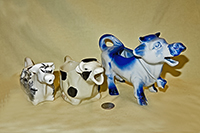 |
Here are three modern English versions that have each been produced by quite a few potteries. The one on the left is marked for Burleigh ware, the middle one for Wood Potters of Burslem, and the big flow-blue one for Royal Crownford. I have perhaps a half dozen or more of each mold, from different makers, but these three each have their own story which is perhaps worth a short introduction here. One of the very few older firms still running under family (albeit a different family) ownership - and in the same location at the Middleport Pottery since 1888 - is Burleigh Dorling & Leigh, now trading as Burleigh, see www.bureleigh.co.uk. This firm began as Hulme & Booth in 1851, and in 1862 was taken over by William Leigh and Frederick Rathbone Burgess (thus Burgess and Leigh, thus Burleigh). It came totally under the Leigh family in 1919. They built up an export network that thrived until a ‘run of financial difficulty’ in 1999 led to the sale to the Dorling family, who now run the business. The web site claims that they’re the last working Victorian pottery factory in England. They pride themselves on their blue and white china, and note that they “use ball clay from Devon; china clay from Cornwall and the unique skilled decorating process of underglaze transfer printing.” The potteries web site traces the history of various Woods enterprises. Their story begins in the mid 1700s with three brothers – Ralph who’s best known for Toby Jugs, Aaron who was the finest mould maker in Staffordshire, and Moses. Wood & Sons prospered under members of the family until the recession of the late 1970’s, then under a receivership was acquired by the Yorke family in 1982. Wood & Sons called in the receivers in 2005. Other Wood enterprises included that of Arthur whose Bradwell Works in Longport operated from 1904 to 1928, and from then until 1989 traded as Arthur Wood & Sons Ltd, when it was acquired by Price and Kensington. They are both now part of the Rayware Group. Another Wood, Tony, a 9th generation direct descendant of Ralph, operated his Tony Wood Studios from 1980 till ~1991. Royal Crownford is one of the trade names of J H Weatherby & Sons Ltd, whose firm was founded in Tunstall in 1891 and moved to the Falcon Pottery in Hanley the following year, finally closing in April 2000. Its other brands included J H W and Sons, Weatherby, and Falconware. |
| |
| Germany: There are a number of very fine German porcelain and ceramics factories that have made some superb cow creamers, notably Goebel, Royal Bayreuth, and Schafer and Vater. These figure prominently in my collection and are covered under Favorite Brands, with Royal Bayreuth also featured on the Heads page.. In addition, there seem to be quite a few other makers who have produced some lovely examples such as those shown here. Many of these are porcelain and many of them have “Germany” and a mold number inscribed on the lower side of their belly, but few to none have a maker's mark. In addition to those shown here, most of the nicer early ‘souvenir picture’ creamers in the Advertising and Souvenirs page are also of German manufacture. Since there were so many active German potteries in the late 19c and early 20c, and since borders changed during those years, I have no way of knowing more precisely who made these or where. | |
|
|
 |
Germany is also noted for silver cow creamers, albeit the only ones I have seen are late 19c or 20c, and from what I can tell, mostly made for export. These three all are 925 silver although many German ones are 800 silver. The big statuesque one does not bear any maker's mark, but apparently was a quite popular pattern. I have 2 of them. The little one in the middle is marked "sterling" and also bears a "B&Z" mark for the US importers, Bucholz & Zelt of New York. It it typical of the small herd of 'single-serving' silver cow creamers in my collection, many of which are also German and several of which came through B&Z. The little one on the right is one of serveral I have that comes from Hanau, famed not only for the number and quality of its silversmiths, but also for the use of "pseudo-marks' in defiance of the German assay office regulations. This one bears the mark of Johan Sigmund Kurz & Co., active from around 1848 until the 1960s. They were noted for working in the 'antique' style. This cow came to me from Germany, so presumably it was initially sold and used locally. |
|
In adition to its lovely realistic cow creamers, German potteries - especially those in the Rudolstadt area where Schfer and Vater was located - are also noted for their humerous (and occasionally weird) ceramics. Here are just two examples, a very strange looking cow and a nursemaid that ended up as a British souvenir. |
|
|
|
|
|
|
|
|
|
|
|
|
Poland: The center of Polish pottery is the city of Boleslawiec, ~120km west of Warsaw, on the Bobr River in SW Poland near the German (Silesia) border. Pottery making in this area, which is renowned for its white clay, dates back to around the 7c. Boleslawiec is apparently sort of a Polish version of Stoke-on-Trent in England or Rudolstadt in Germany (I haven't visited it [yet], so this is just a guess); at any rate, it has a lot of pottery factories. Brightly decorated Polish dinnerware from this region seems to be extremely popular in the US these days; some even showed up at an Alaskan Army base PX we visited. Using the web as a guide, I find that the cow on the left in the left hand picture, is from Zaklad Ceramiki Artystycznej "TYRCZ", and the one on the right is from Zaklad Ceramiczny Stanislaw "WIZA" which is in the village of Parowa, about 13 km west of Boleslawiec. The smiley creamer in the center of the left picture, and the one on the left of the right shot, are most likely from Ceramika Szlachetna "DANA", which was established in 1975 and prides itself on continuing to use only traditional hand-made techniques; thus each of their pieces is marked "UNIKAT", which means unique. The little smiley guys with the tiny round mouths are pretty obviously from the same area, but I don't have their precise pedigree. To learn more about Polish pottery, Boleslawiec, and the various factories there, check our www.artisanimports.com/Polish_Pottery/About_us.html |
|
|
|
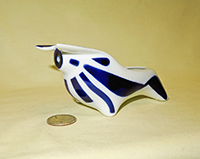 |
This definitely is a cow albeit from its size less likely a creamer than simply a decorative piece, distinctively Spanish and impressed for Sargaledos, which is a fancy ceramics gallery in Barcelona. I also have a silver Spanish cow creamer and a number of rather more 'normal' shape. |
|
|
|
Mexico: This is a particularly fine example of Mexican folk art; I bought it on eBay, and the seller indicated it was made by Guilermina Aguilar of Ocotlan de Morales, Oaxaca. It arrived with the horns broken, but after considerable trouble I had them restored – it was nice enough to justify the effort!. |
|
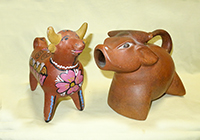 |
Here are two more Mexican clay jugs or pitchers - probably more intended for tourists than any real use. The eBay-seller of the one on the right said he bought it in a crowded market in Nogales, Mexico in 1996 and described as patterned after Mayan design. I have a similar black one also. |
|
|
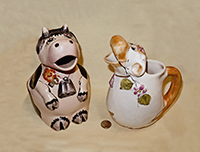 |
Chile: The large pitcher on the left is stamped “Ceramica San Juan MR” and “Penco-Chile”, and the one on the right “Asem, Chile” in script. |
 |
Brazil: Two red clay wine pots from Brazil. From the number I've seen on ebay they make popular souvenirs. I also have a couple ceramic pitchers and creamers from Brazil |
|
Peru: One of the most characteristic Peruvian pottery items is the Torito De Pucara, or Little Bull of Pucara. Pucara is located northwest of Lake Titicaca, some 140 Km southeast of Cusco on the road to Puno and the Lake. The town derives its name from the Pukara culture which flourished from about 200BC to 800AD. It has been a center of pottery manufacture for over 2 millennia, and remains the largest ceramics producing area in southern Peru. The Torito is a good example of the fusion of local Andean and Spanish cultures: the bull is a typically Spanish symbol of strength and courage, but it was adopted by Andean craftsmen in the later part of the 18c (recall the Spanish conquered the Inca empire in the mid-16c). Various web sources state that the Torito originated as a ritual element for the cattle-branding ceremony, as a flask to contain a mixture of chicha (a corn based beer) and cattle blood, drunk by the priest conducting the ceremony. These days, in addition to serving as a vase and a popular tourist item, a pair of Toritos (for prosperity and fertility, since bulls now provide the main power for plowing on most farms), often accompanied by a cross and two bottles or jugs (one for holy water and one for chicha, again showing the intermixture of cultures) is installed on the roof of houses. Our local guide stated that while the walls of farm homes are usually home-made from dried mud, the roof tiles must be bought, and thus the completion of a (costly) roof is a time for celebration, as well as the invocation of both Catholic and indigenous protective forces for the home. The same seems to apply to this stone home with a thatch roof in Ollantaytambo, albeit here the 'bottles' are somewhat less than traditional. |
|


|
|
|
|
|
|
|
|
|
|
|
|
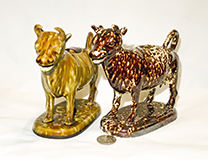
|
U.S.A.Since the northeastern portion of the US was settled by Brits, it was only natural for some enterprising potter to start producing cow creamers that bore at least a family resemnblance to those from Staffordshire. While there may have been some that are earlier than those shown here I have never found any. Thus what is referred to as American Rockingham ware from the glaze, or Bennington from where they were made in Vermont starting in the late 18c or early 19c, will have to serve as examples of early American cow creamers. Although I have only a limited number of these, their quality and status (plus the fact that I'm a Yankee myself) entitles them to a page of their own. |
|
|
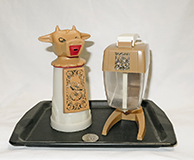 |
This is about as American as you can get - a Whirley Moo Cow Creamer, shown here in a set with a sugar dispenser. They were hugely popular in the 1970s, and millions were sold in roadside restaurants. These days they are one of the most prolific cow items on Ebay. I just checked and found about 290 of them on offer. You can read a whole lot about them on the Advertising and Souvenirs page. |
|
|
|
|
 |
Canada: I have bought many creamers in and from Canada, but know of few that were made there. Here are three Canadian-made creamers from McMaster Pottery which was founded by Ohio-born potter Harry McMaster and his son Robert in 1939 in Dundas, Ontario (it and other McMaster enterprises are now part of the MMG Group). The dark brown one with red drippings in the glaze is particularly interesting because it’s made from red clay, is a souvenir from Ft Macleod, Alberta (just an hour’s drive eat of the Rockies), and still bears the red and gold “McMaster Craft” stamp on its rump. |
 |
These two creamers reflect the Ukranian heritage of many of the settlers in central Canada –They are from quite standard molds and may not have been initially made in Canada but were almost certainly decorated there. They bear Ukranian decorations from (l) Ceramic Cottage Vegreville, Alberta, and (rt) Diana May Clay, Ltd of Saskatchewan. |
 |
From the seller and Wikipedia we learn that in 1950 21 year-old Dennis Tupy left his native Czechoslovakia and heaed to Halifax. He ended up in Collingwood, Ontario, Canada. With the help of Jozo Weider (a fellow Czech), founder of a ski resort on the slopes of Blue Mountain in Collingwood, in the fall of 1953 he launched the Blue Mountain Pottery. Originally producing hand-painted ski motifs on purchased blanks, production of red clay items like this creamer started in 1953-1954. They went on to produce various types of pottery, from animal figurines to jugs, pots and vases. Blue Mountain Pottery items feature a unique, trademarked glazing process known as "reflowing decorating." Two different liquid glazes, one light and one dark in color, were applied. During the firing process the glazes would run, creating streaking patterns unique to each piece. In 2004, foreign competition and changing tastes led to Blue Mountain pottery's closure, although its pottery is widely collected and has spawned a Collectors Club. This creamer celebrates Timmins, located in NE Ontario, noted for its lumbering and mining industries. |


